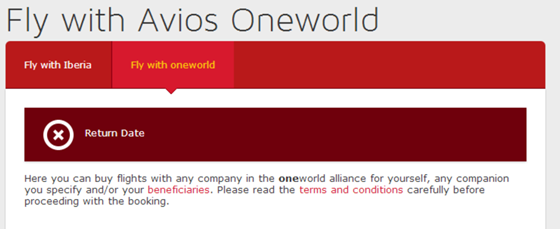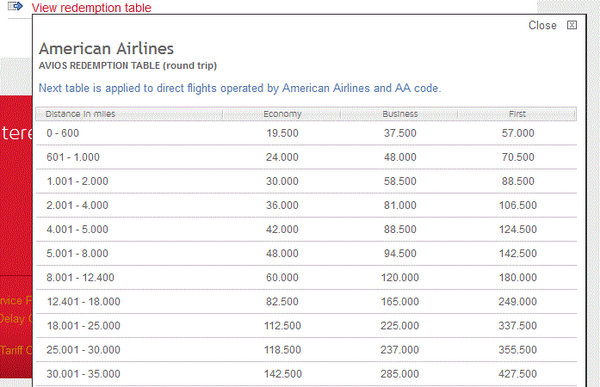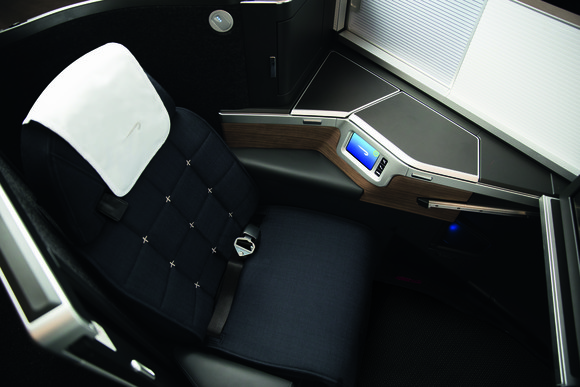NOTICE: This post references card features that have changed, expired, or are not currently available
Iberia and British Airways share the same miles program called “Avios”. Recently, Iberia published a partner award chart that is quite different from British Airways’ own partner award chart. Some fear that British Airways will soon follow Iberia’s lead.
UPDATE: It turns out that Iberia’s partner award chart has not changed. The chart shown below is the same as it always was. That said, this post highlights some areas where this award chart may actually be useful…

The British Airways award chart starts at just 4500 Avios for flight segments of 650 miles or less. When using Iberia Avios to fly with their Oneworld partners, Iberia now charges a minimum of 19,500 miles for round-trip itineraries of 600 miles or less.
The following table is borrowed from this Miles4More post. Iberia has a slightly different chart for American Airlines (shown below) than for other OneWorld partners, but it’s close enough for our discussion purposes.

Here is the OneWorld chart:

The only obvious difference between these charts is that the OneWorld chart allows for greater distances, and the 0-600 mile cost for Business awards is 2000 Avios more for American Airlines. The latter makes me wonder if the differences are simply an error?
How it works
The Free-quent Flyer wrote a great post about how he stumbled upon the Iberia partner award chart [see Breaking: Iberia goes bizarre, British Airways award chart intact (for now)]. In his situation, Iberia actually priced his award slightly cheaper than the equivalent British Airways award. How can this be?
The answer is that, while both charts are distance based, they work very differently. British Airways will charge you separately for each segment you fly whereas Iberia will charge you for the total distance flown regardless of the number of stops. British Airways allows one-way awards. Iberia allows round-trip awards only.
The Free-quent Flyer also found that if you mix and match class of service (i.e. coach, business, first class) within an award, Iberia blends the award cost accordingly. This is interesting since most airline programs will charge you for the highest cabin of service within your outbound or return itinerary. The Free-quent Flyer observed that this might make it possible to perform some hacks to reduce the cost of awards.
I ran a number of scenarios with Iberia awards on American Airlines flights and found that Iberia calculates the award cost as the weighted average based on the distance flown in each cabin. For example, if 25% of your flight is in coach and 75% is in first class, then:
- The total miles flown (round trip) determines which row of the chart will be used.
- If 25% of your flight is in coach, then multiply the coach award price by .25
- If 75% of your flight is in first, then multiply the first class award price by .75
- Add up the results.
- Fuel surcharges and taxes appear to be unaffected by class of service.
Another test I ran was to see whether Iberia chooses the row in the award chart based on the distance between the origin and destination, or on the distance actually flown. For example, non-stop San Francisco to Frankfurt would be less than 12,000 miles round trip, but with a layover each way in Charlotte, the actual flown distance would be over 13,000 miles. That makes a big difference in the price of the award. I found that Iberia prices awards based on the actual route to be flown. In other words, added layovers add distance and can increase the award price.
It’s bad, but not all bad
When comparing the Iberia partner chart to current British Airways sweet spot redemptions (such as NYC to Toronto, CA for 4,500 points each way), the Iberia chart looks awful. And, in many scenarios, when comparing the Iberia chart to zone based awards from traditional carriers (AA, Delta, etc.) , the Iberia chart looks bad or awful (generally, it looks worse as the distance traveled increases). There are some spots, though, where Iberia’s award chart is pretty good, or at least competitive with traditional programs.
For example, US to Europe, round trip, costs 60,000 miles in coach or at least 100,000 miles in business class with most airline programs. With Iberia, the price depends upon on distance to be flown. From the east coast, some will find round trip coach as low as 48,000, and business as low as 94,500. This is better than most competing programs. From the middle of the US, most awards will price at 60,000 in coach and 120,000 in business (roughly equal to most competitors); and from the west coast some will see award prices as high as 82,500 in coach and 165,000 in business. So, with the exception of flights from the west coast, Iberia redemptions to Europe are not awful. Except, they are kind of awful when you factor in the added fuel surcharges… Sigh…
In addition to situations where Iberia partner awards beat out airlines with zone based awards, there are also times where the Iberia chart is cheaper than the British Airways chart. In general, non-stop round trip flights in the 11,000 to 18,000 mile range will be a bit cheaper than the same trip with British Airways miles. And, flights with layovers will often be cheaper with Iberia’s chart because of of the way British Airways counts each segment as a separate award.
Given that there are at least some Iberia partner awards worth looking at, lets see if there are opportunities to reduce award costs to get an even better deal…
Reducing cost through coach segments
When booking online, Iberia requires round trip awards and does not allow stopovers or open-jaws, so options are limited (more options might be available by calling their service center – I haven’t had a chance to look into that yet). The main hack I see is the ability to reduce the cost of a premium cabin award by including coach class segments. Suppose, for example, you want to fly overseas and it will require three flight segments (two stops): segment 1 is your flight to the international gateway city in the US; segment 2 is your overseas flight; and segment 3 is the flight to your final destination. Since it is usually the case that domestic first class / business class is barely better than coach, you could book segment 1 in coach; segment 2 in business or first class; and segment 3 in coach. If segments 1 and 3 are relatively long compared to segment 2, the overall Avios cost of your flight will be much less (since a substantial portion of the flight will be priced at the coach level instead of the business or first class level).
Reduce cost through reducing distance
In some situations you may find that your round trip flight distance just barely pushes you over into a higher cost award band. In those cases, it might be worth buying a ticket (or using another award currency) to position yourself a bit closer to your final destination. Whether or not its worth doing this greatly depends upon how much you would save. The increases in award prices from one distance band to the next are not uniform. Dropping to a lower band will have huge impact in some cases, but not others. For example, dropping from the 18,001–25,000 band to the 12,401-18,000 band will save a whopping 30,000 points in coach and 88,500 in first. However, dropping from the 25,001-30,000 band to the 18,001–25,000 band will save only 6000 Avios in coach and 18,000 Avios in First.
Throw away return
If you want to book a premium cabin one-way flight, you can reduce your losses by booking a return trip entirely in coach. For example, Miami to Seoul (via Dallas) round trip in first class would cost 249,000 Avios. If you book just the outbound in first class, and the return in coach, the entire flight would cost 166,897 Avios (plus 270 Euro in each case). 167K is far from cheap for a one-way award, but there may be situations where its worth it.
Save by going further
I don’t think this is a practical solution, but I’ll offer it up for completeness. Suppose you find that the flight you want to take is in the middle or low end of a distance band on Iberia’s award chart. And, suppose you’re eyeing a long distance premium cabin award. In that case, you could theoretically save Avios by starting your journey further away from your goal, or picking a further away goal, so as to increase the percentage of time you’re in coach. This will have the affect of reducing the overall award price. It’s hard to imagine a situation, though, where the extra flying in coach would be worth the effort towards reducing the cost of a premium award. Also, keep in mind that this might increase fuel surcharges. OK, forget that I brought this up at all…
Wrap up
When compared directly to British Airways’ current award chart, the Iberia partner award chart is downright scary. If British Airways were to adopt the same chart, many of the best short distance redemptions available today would go away (see “Big Wins”). That said, there are circumstances where the Iberia chart is as good as or better than many competitors. The great thing is that Avios can be freely transferred between British Airways and Iberia so, for now anyway, we have the luxury of picking the award chart that best meets our needs.





>> snip
I had a HOLY Sh!T moment when I read this… before I realized you meant REAL miles, as in distance– as opposed to “miles” meaning points!
This was debunked early yesterday so plenty of time for a better post. It looks like the prepackaged template phenomenon has hit FM too.
-1 to comment
Did you even bother to read the post before writing that? There’s good info here.
Iberia’s chart has been the same since 2011. I don’t see any changes here.
I was just talking about this last night as well. Iberia’s chart reminds me a lot of ANAs chart, but ANA has better redemptions at just about every mile-flown level.
The devil is in the details also – so knowing how many stopovers are allowed would be nice to know (I didn’t see that anywhere on Iberia’s site)